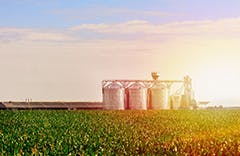Whenever possible, don't enter a grain bin. If you must enter the bin, as a farm owner/operator you should:.
- Break up crusted grain from the outside of the bin with a long pole. When using a pole, check to see that it doesn't come into contact with electric lines.
- Wear a harness attached to a properly secured rope.
- Stay near the outer wall of the bin and keep walking if the grain should start to flow. Get to the bin ladder or safety rope as quickly as possible.
- Have another person, preferably two people, outside the bin who can help if you become entrapped. These people should be trained in rescue procedures and should know and follow safety procedures for entering the confined space.
- Grain fines and dust may cause difficulty in breathing. Anyone working in a grain bin, especially for the purpose of cleaning the bin, should wear an appropriate dust filter or filter respirator.
- Stay out of grain bins, wagons and grain trucks when unloading equipment is running.
- If it is necessary to enter the bin, remember to shut off the power to augers and fans. It is a good idea to lock out any unloading equipment before you enter a bin to prevent someone from unintentionally starting the equipment while you are in the bin.
- Children should not be allowed to play in or around grain bins, wagons or truck beds.
- Where possible, ladders should be installed inside grain bins to for an emergency exit. Ladders are easier to locate inside a dusty bin if there are brightly painted stripes just above or behind the ladder.
Grain bins are commonly found on Illinois farms. These bins are used to store grain such as corn, soybeans, wheat, oats, and grain sorghum.
Grain being stored is removed through an opening in the center of the bin. As you can see, this process pulls the grain down and toward the center of the bin. You can see how a depression in the middle of the grain is formed.

Grain wagons can be a hazard, particularly to youngsters. The grain in a grain wagon acts just like the grain in a bin when moving. It pulling down on whatever might be in the grain and children are not strong enough to pull themselves out of the moving grain.
Vertically crusted grain can collapse on a farmer attempting to break it up while in the bin.
Grain crusted on the surface can be over voids (open spaces) and a person's weight can cause the grain to collapse and the person can be covered with grain.
If someone is in the bin when the grain is removed, they, too, will be pulled down and toward the center of the bin. If grain continues to be removed the person will be covered with grain in a matter of seconds!

As you can see, this person has been pulled down into the grain and pulled toward the center of the bin. Once the person as been pulled into the grain above their knees, they cannot get out of it by themselves. The pressure of the grain on their legs and the grain flowing down as they try to move gives them no place to go.
A sweep auger helps to collect grain when the bin is almost empty. Because it goes slowly in a circle on the floor, it can be an entanglement hazard to someone in the bin when it is operating.
https://extension.illinois.edu/agsafety/equipment/grainbinsafety.cfm

Grain Handling Safety
Grain handling is a high-hazard activity, where workers face serious injury and death. Youth should not be in grain bins or silos or in/around flat storage structures unless they are empty, proper lock-out/tag-out and other safety procedures are followed, and the youth is at least 16 years old.
Grain handling is a high-hazard activity, where workers face serious injury and death. Youth should not be in grain bins or silos or in/around flat storage structures unless they are empty, proper lock-out/tag-out and other safety procedures are followed, and the youth is at least 16 years old.
You and/or your employee(s) can use this form to complete safety checks on your farm. Use the blank lines to list additional safety checks you think are important when inspecting your grain handling facilities and procedures. Keep the completed forms for follow-up, future reference and inspections. Additional copies of this form can be downloaded at: http://umash.umn.edu/umash-farm-safety-check/



